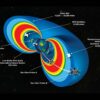Unlike our Milky Way, some galaxies have an active black hole in their center driving powerful outflows of gas. But we know very little about their impact and origin. ESA’s future X-ray mission Athena will change this. In preparation for the launch in the 2030s, astronomers from SRON and UvA have now developed a new method to use Athena to study these outflows.
Astronomical pictures are often full of stars from the Milky Way, but some of them are imposters. Instead of simple stars, some dots are in fact centers of entire galaxies. They are so far away they appear as a faint dot and blend in with the stars. This trick has fooled astronomers for decades, until the 1950s, which is why we call them quasi-stellar objects, or quasars for short. Astronomers discovered that the spectrum of some dots was highly redshifted, indicating a large distance at which a star would be invisible from Earth.
Eventually, astronomers realized that the light from quasars must come from the centers of galaxies—called active galactic nuclei (AGN)—probably powered by a supermassive black hole. Cosmological models predict that these AGN are the powerhouses altering the evolution of galaxies, by attracting and ejecting massive amounts of material from their vicinity.
Elisa Costantini and her team at SRON Netherlands Institute for Space Research, including Anna Juranova, and in collaboration with Phil Uttley at the University of Amsterdam, are studying these outflows from AGN using X-ray space telescopes. In preparation for the launch of ESA’s new X-ray mission Athena—to be launched in the early 2030s and with a substantial contribution of SRON—the team has developed a new method to study AGN outflows. AGN brightness can be highly variable in time, especially in X-rays. The researchers will use Athena’s X-ray spectra to see how the outflows respond to these brightness variations.
“In the end, we want to understand what drives the outflows and what impact they have on their host galaxy,” says Juranova, who led the work. “For that, we need to know the density and location of the outflow. And to know that we need information about the timescale at which the light from the AGN ionizes the outflowing gas. Thanks to our simulations, we have found a way to measure this gas response in outflows with different properties. When we get the actual data from Athena, we compare them to our models and determine which one matches the observations best.”
To identify the outflows by their behavior, the research team uses frequency analysis. Juranova says that “you can compare it to the temperature in The Netherlands. It goes up and down in a daily cycle, but also in a yearly cycle. With the analysis we use, you can easily disentangle the different types of changes, because they are happening at separate frequencies corresponding to these two cycles. And that is very helpful because we can then study these processes individually. Similarly, the light from the AGN changes in time because of processes happening at different timescales, from hours to years, and so the frequency approach helps us understand what is going on there.”
More information:
A Juráňová et al, Spectral-timing of AGN ionized outflows with Athena, Monthly Notices of the Royal Astronomical Society (2022). DOI: 10.1093/mnras/stab3731
Provided by
SRON Netherlands Institute for Space Research
Citation:
New method to study outflows from galactic centers in preparation for Athena (2022, March 28)



